
Written by Kathleen Goodwin
Food is more than what we eat. It is who we are. Foods vary based on our culture, and food has the power to render happiness, create memories and bring people together. In Missoula, we are a little bit obsessed with good food, in all forms. We live for local and are always more than ready to try new menu items from bakeries, food trucks and more. But outsiders to our community might be surprised to hear that one of our most cherished and inventive food spots is not a restaurant, but a grocery store. The Good Food Store has been a part of Missoula since the early 1970s, and it is so much more than just a grocery store. It is a welcoming, intentional and unique hub for the community and the regional local food movement. Destination Missoula sat down with Layne Rolston, Communications Director at the Good Food Store, to discuss the store’s history, its vast community impact and the many reasons why we should all be celebrating really, really good food.
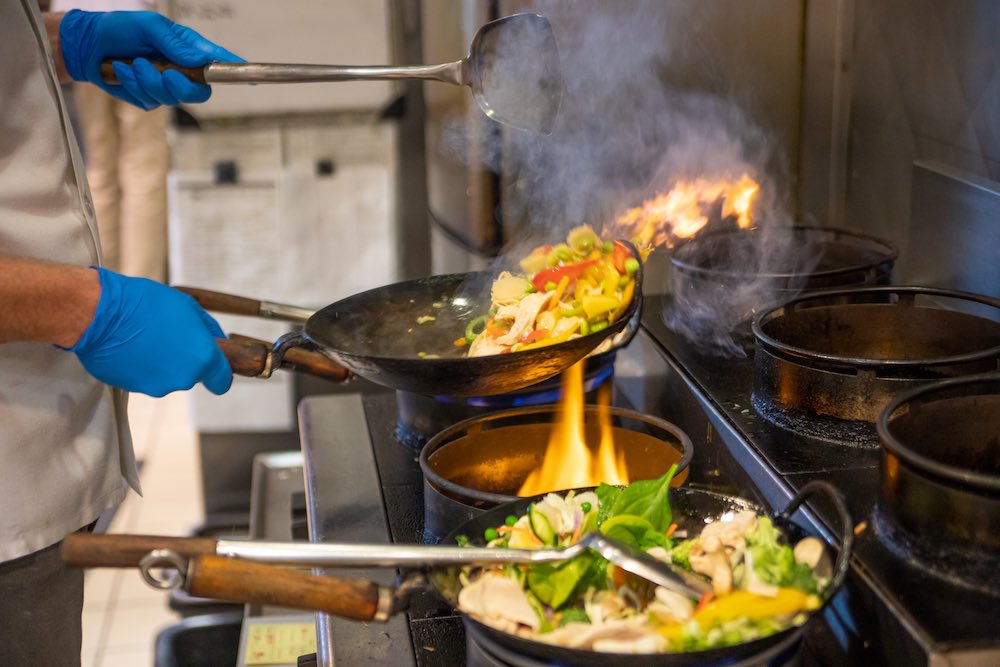
Build your own wok bowls are prepared to order. Photo courtesy of the Good Food Store.
In the early 1970s, the folks who created what is now known as the Good Food Store did not set out to start a grocery store. A small group of friends decided they wanted to purchase bulk staple items, such as beans and rices. The word got out and soon more and more people wanted to join in. Within a short time period, the idea grew from a small group of individuals into a business with a storefront that first opened its doors in 1971. The original store, called Mr. Natural’s, was the first iteration of what we now know today as the Good Food Store. Over the course of 50 years, the retail store has gotten bigger and bigger. From its original home at Beckwith and Higgins, the Good Food store has seen many homes and many storefronts. Though it is now located on 3rd Street, when many locals think of the Good Food Store they think of the storefront on Kensington Avenue, where the store was located for more than 20 years. From its origins, the store has been community centered and oriented.
“When we were moving from the Main Street location to the Kensington Avenue store, our customers and folks from the city helped carry our stock into the new building,” Layne shares. “In May 2003 we moved into our current location and roughly quadrupled in size from that Kensington store.”
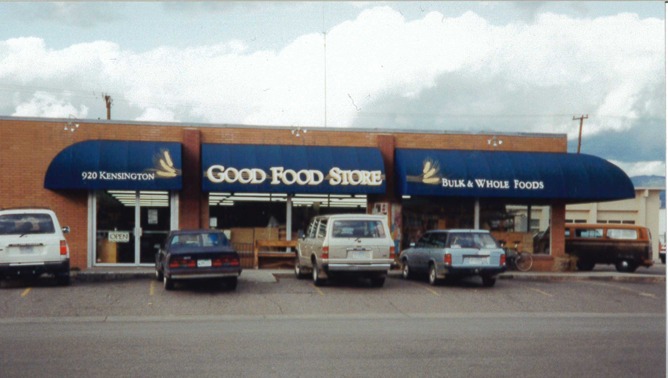
The Kensington Avenue storefront in October 1992. Photo courtesy of the Good Food Store.
From humble origins with bulk foods to the multi-faceted business it is today, the Good Food Store has seen many changes. Starting with bulk and soon after integrating produce and meats, the store now has 12 departments: Produce, Bulk, Perishables (including dairy, frozen foods and non-dairy “dairy”), General Grocery (such as packaged items), Meat and Seafood, Cheese, Beer and Wine, NEST home decor and kitchenware, Health and Beauty, Deli and Café. The Good Food Store employs more than 300 people, many of whom have been working there for more than 20 years. People remember with pride their first visit to the Good Food Store, and for good reasons. There is something special about the place. It transcends what one would expect from a grocery story into something more.
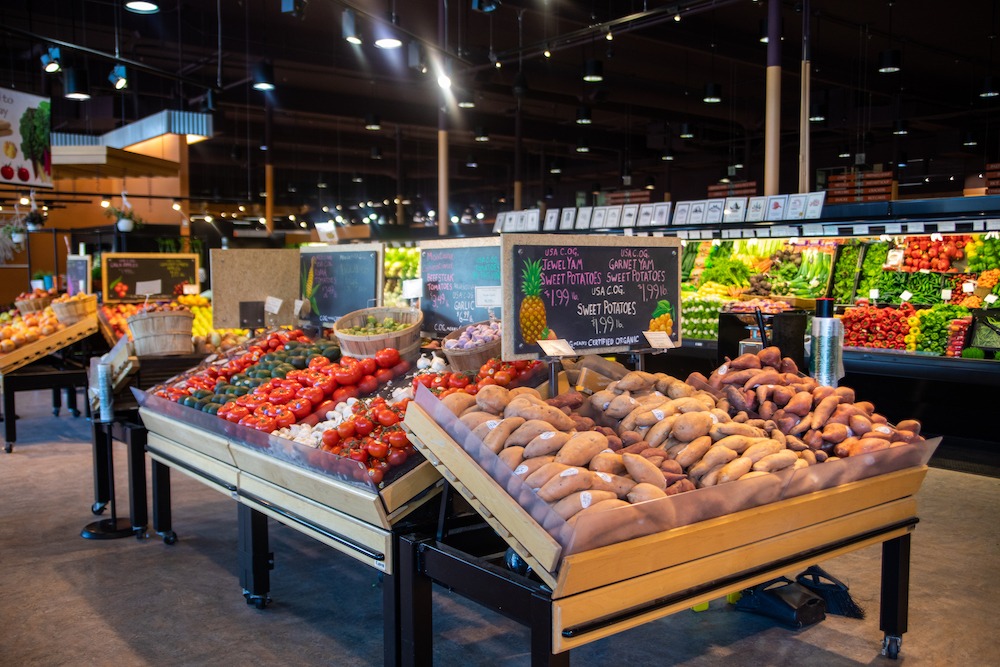
The produce section of the store varies throughout the year, stocked with seasonal and local produce. Photo courtesy of the Good Food Store.
Staying true to its roots, having a hearty bulk food selection has always been central to the Good Food Store’s product line. Bulk foods are traditionally thought of as things like rice, beans and lentils, though that selection has extended to include many more items at grocery stores throughout the country. Things like snack foods, shelf staples like flours and sugars, coffees, nuts and oatmeals are also common bulk items that can be found. But the Good Food Store takes it several steps further. We’re talking bulk spices, pastas, cheeses, condiments, and even local yogurts and salsas. Bulk is about more than buying lots of an item. Sometimes, it is simply about buying a little of an item, which is an even bigger deal sometimes.
“There is a new wave of bulk appreciation happening now. We are seeing people really paying attention to waste, both packaging waste and food waste,” Layne explains. “People are recognizing ‘Hey, why would I buy a product and let it sit on my shelf and let it get old when I can buy the exact two cups that I need in the bulk department?’ There is a resurgence of people’s love of bulk foods.”
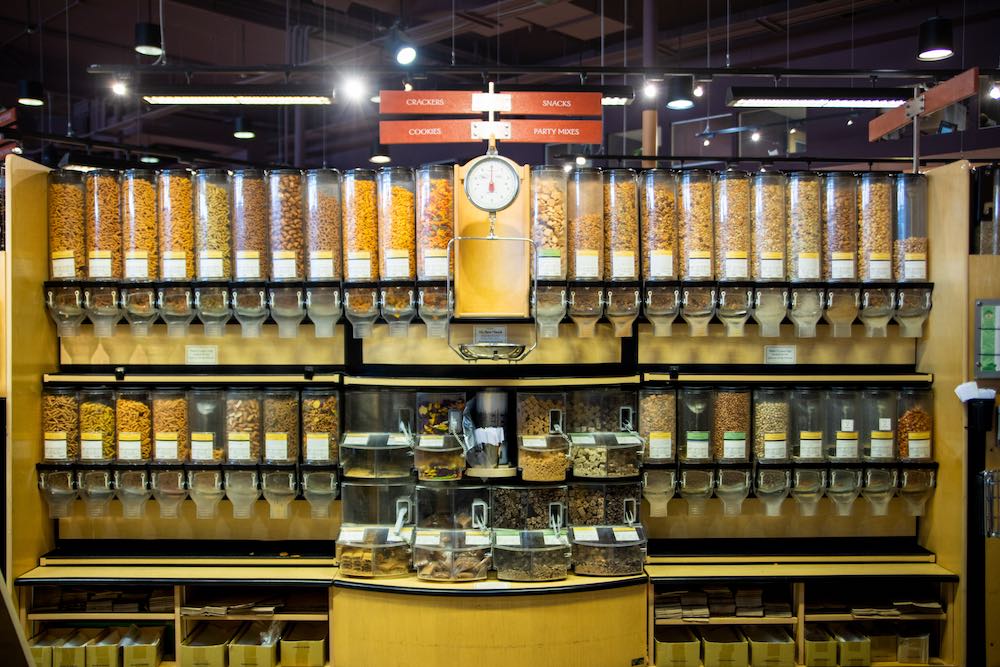
One of many, on this bulk food aisle you can find snacks like goldfish, sesame sticks and pretzels. Photo courtesy of the Good Food Store.
It seems that everything but the kitchen sink can be found here. Do you want a vegan doughnut? They have those. Seasonal kitchen decor? They have that too. Cruelty-free organic makeup products? Pizza from a fire deck? Bulk laundry detergent? Yes, yes, and yes. And while the Good Food Store has changed and the product line has grown over the years, their commitment to sourcing real foods, and sourcing local foods, has remained constant.
“From very early on once the retail store started, it became important to source as much local food as possible. Places like Lifeline Produce in the Bitterroot started way back in the 1970s and have been a part of the Good Food Store forever.”
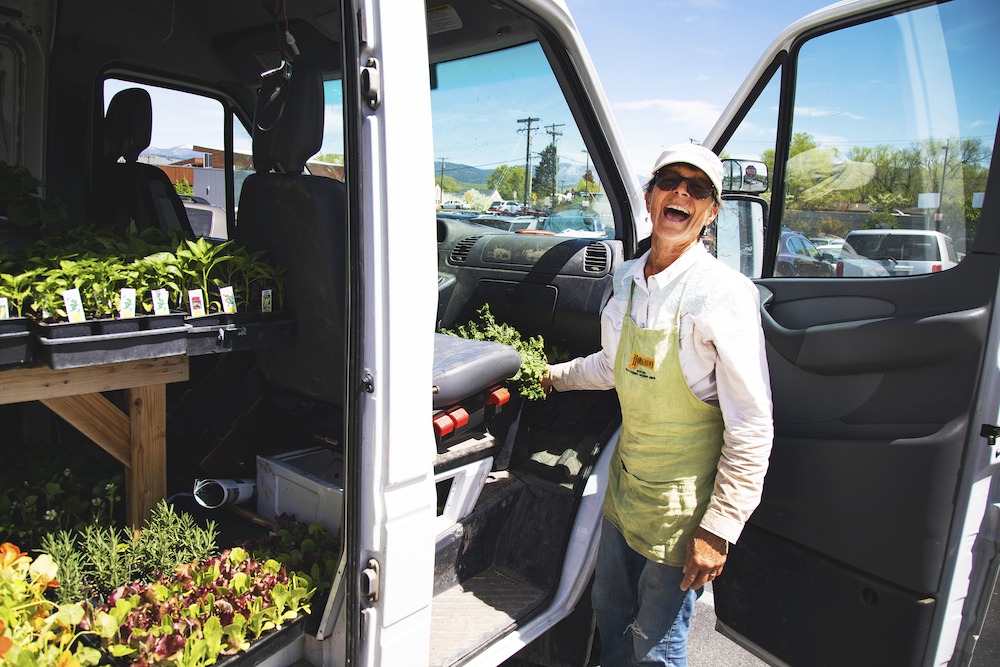
Luci from Lifeline unloads starter plants at the Good Food Store in the spring. Luci and Steve from Lifeline have worked with the Good Food Store as a produce provider since the 1970s. Photo courtesy of the Good Food Store
The store now sources more local product variety than any other grocery or retail store in the region. The list is extensive and covers more than local veggies and fruits. You will find local cheese from places like Tucker Family Farms and Lifeline, meats from Oxbow Cattle Company, Living River Ranch and Mannix Beef, produce from Harlequin, Lifeline, Clark Fork Organics and dozens more, breads from Le Petit Outre, Grist and Wheat Montana, packaged foods from Hot Mama’s Salsa, Big Dipper Ice Cream, Wustner Brothers Honey, Arthur Wayne Hot Sauce—and the list goes on and on. And not only does the Good Food Store provide customers with excellent selections of local products, something important to so many Missoulias, the store also gives these various farms, ranches and businesses a venue to sell their products year round.
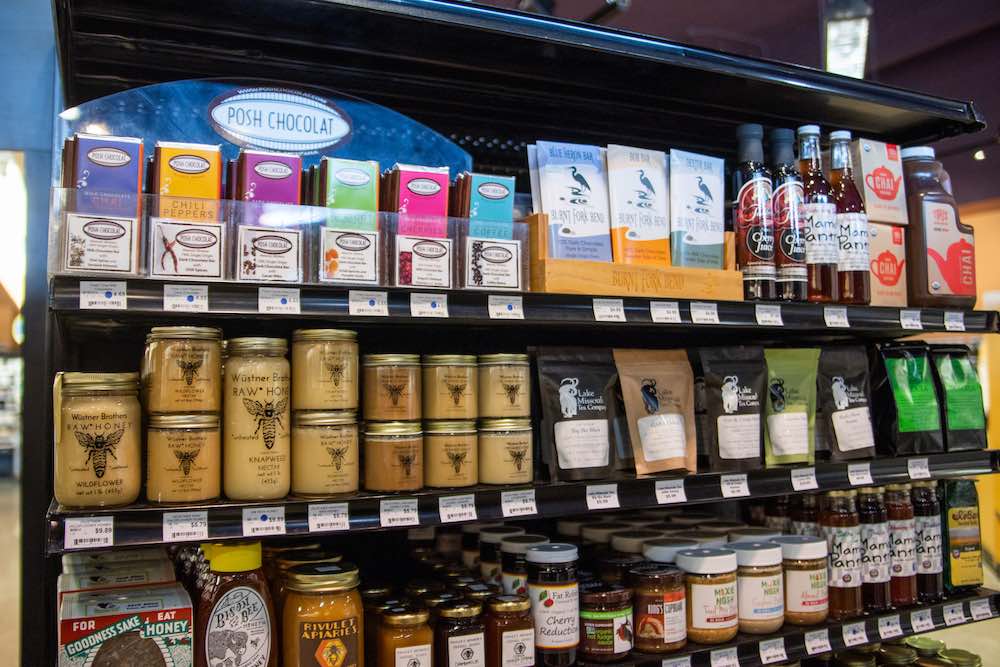
Locally made products are stocked on the shelves year-round. Photo courtesy of the Good Food Store.
“One of the most satisfying things about the store is the number of local businesses that truly have become successful because they can sell their product at the Good Food Store. Local has been part of the culture for the full history. It was really important to those who started the store that it was a community store. Having relationships with local farmers was important from very early on, and they realized how important eating local was to a segment of the population. It was a small group of people in those early years, but in the last couple of decades, local food has become important globally. It is important for a much larger segment of the population than it ever has been. The store has had local foods as a focus for a long time, and it is almost like that early Good Food Store priority has become the priority of so many more people.”
And it is true. The local food movement is not new to Missoula and has been at the center of the community for some time. Layne says that some credit lies with places like the University of Montana’s Environmental Studies Program, the PEAS Farm, and Garden City Harvest, who have been operating to create food sustainability on a local level for decades. But it is much more than any single organization. It is much more than the Good Food Store. It is the Missoula, and Montana, community. People here march to the beat of their own drum, and that translates to local foods, too. In Missoula, it seems that almost every person you meet sources at least some of their food themselves, from home or community gardens to backyard chickens to fruit picking near town and hunting and fishing wild game. And that self-sufficiency extends to the pride we feel when it comes to eating local. The Good Food Store is one of the main providers of access to these local foods in Missoula, something that is so near and dear to so many people.
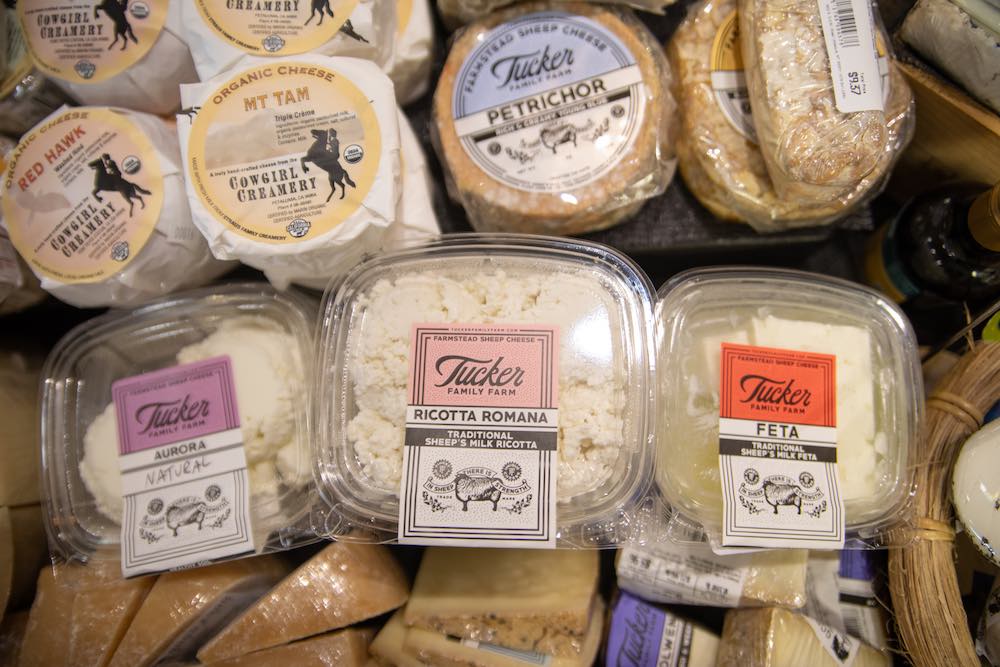
Many local products can be found throughout the store, including local cheese by Tucker Family Farm. Photo courtesy of the Good Food Store.
When it comes to the local food movement and community in Missoula, the Good Food Store sits in the middle of it all. It seems to be a culture that feeds on itself: people believe in eating good, real foods so they shop at the Good Food Store. The store, in turn, gives local businesses and farmers and ranchers a chance to sell their products, thus growing the movement. Additionally, shopping at the Good Food Store builds Missoula up. The Good Food Store is unique in a major way: nobody owns the store. From its foundation, it has been a community store, and while the store functions like any other business in town in many ways, the fact that they do not turn profits for an owner or stockholders means that they have the chance to invest in Missoula.
“Because we have no owners, it has affected how the profits of the store are distributed,” Layne says. “We don’t have stockholders or owners who are cashing in the profits of the store, so the profits all go back into the store or into the community. That is why, compared to most businesses, we have a really robust community giving program and why we can put nearly $300,000 in donations and sponsorships back into the community each year.”
The recipient list is extensive. In 2018, the Good Food Store supported over 350 local organizations and events including things like Meals on Wheels through the Missoula Aging Services, Poverello Center, Missoula Food Bank, Five Valleys Land Trust, Garden City Harvest, Missoula Symphony, Watson Children’s Center, Camp Make-A-Dream, the Missoula Art Museum, Clark Fork Coalition, the Missoula Marathon and Run Wild Missoula, Big Sky Documentary Film Festival, Home ReSource, Jeannette Rankin Peace Center and AERO. And this is just to name a few. When it comes to who exactly they give donations to, either in-kind or financial, it seems that there is no set list of requirements or stipulations.

Layne Rolston outside the food tent at the Missoula Marathon, where the Good Food Store is the food provider for participants and volunteers. Photo courtesy of the Good Food Store.
“The spectrum is large,” Layne explains. “Food security issues are important to the store. We don’t think anybody should be hungry. Local agriculture groups are also a high priority, and local agriculture issues often blend into environmental issues, too. Also important are nutrition programs and fitness groups. But we also feel like the arts are an important part of our community. Of course, we support a lot of things that would fall into social services like Habitat for Humanity, Mountain Line and Youth Homes. There are so many, and they all build Missoula to be what it is.”
People come to the Good Food Store for a variety of reasons. Some come because they know and value the curated products that the store shelves. Some come because eating local matters to them. Others come because they know they will find proportionately higher amounts of organic, gluten free or vegan products compared with other shops in town. Some come simply to enjoy the deli and cafe, which serve up competitively delicious foods. “We get a ton of folks who are stopping here because they know our deli does not serve soup out of a bag or salads out of a box," Layne shares. "Everything is house-made here. I am sure there are people who don’t really care that we are supporting places like the Symphony or Meals on Wheels, but there are a lot of people who do care, who recognize that we are supporting organizations in the community that they feel are important.”
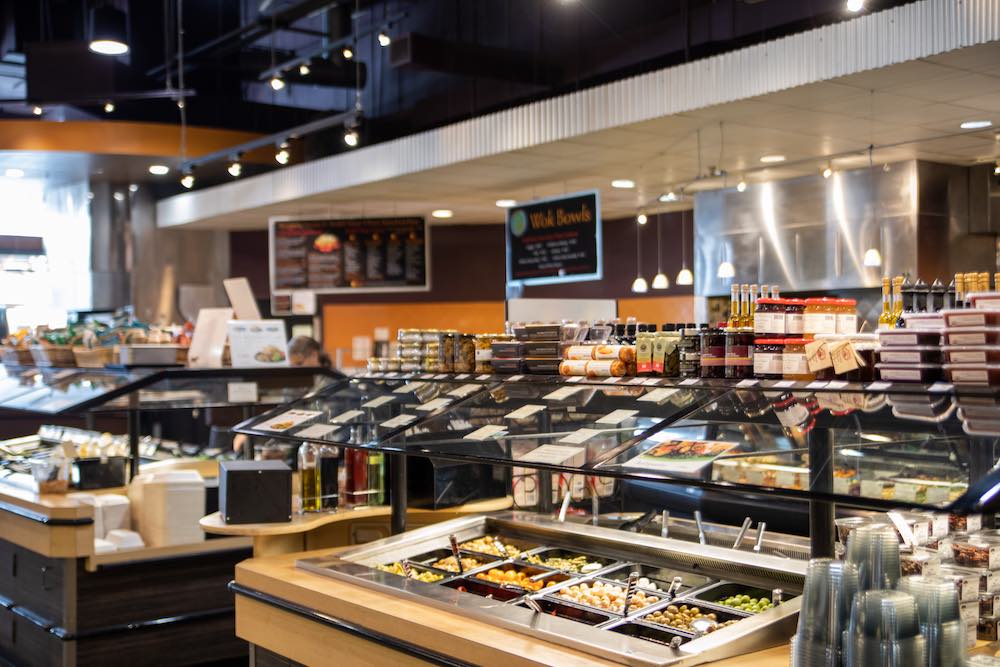
Take it all in. The deli and cafe makes the Good Food Store one of the best places to eat in town. Photo courtesy of the Good Food Store.
The Good Food Store and Missoula have a really special symbiotic relationship where both truly benefit from the other. “We are doing something that the community recognizes as valuable," Layne shares, "and we recognize how important the community is and what feeds this community beyond the food on our shelves—culturally and spiritually. We try to support those things, both in the way we run our business and in the organizations that we support within our community. It feeds on itself. Missoula is unique in the way it supports local food producers. Missoula is unique in a lot of ways. I think the Good Food Store is part of that, we’re a reflection of the unique character that makes Missoula special.”
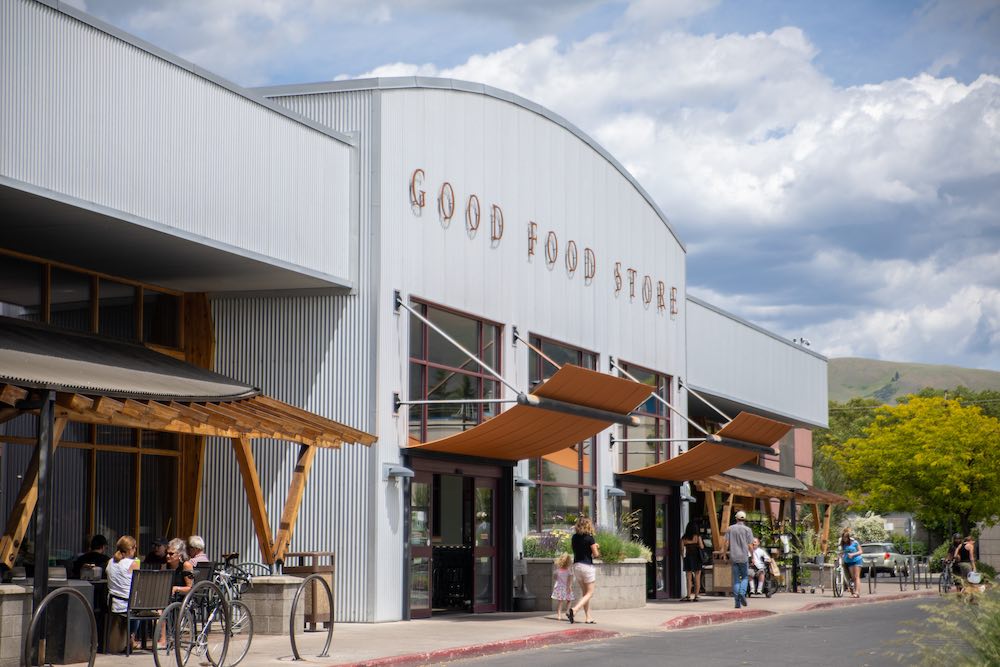
This storefront on 3rd Street has been the home to the Good Food Store since 2003. Photo courtesy of the Good Food Store.
Written: 11/22/19